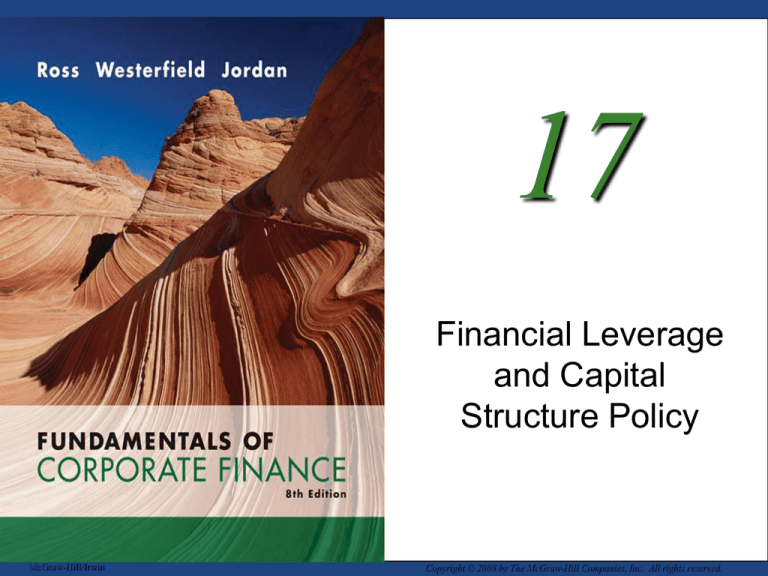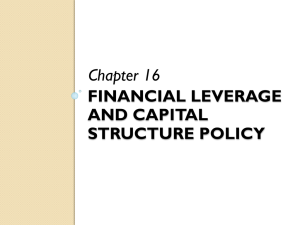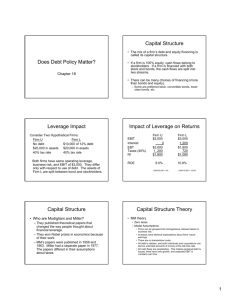
17
Financial Leverage
and Capital
Structure Policy
McGraw-Hill/Irwin
Copyright © 2008 by The McGraw-Hill Companies, Inc. All rights reserved.
Key Concepts and Skills
Understand the effect of financial
leverage on cash flows and the cost
of equity
Understand the impact of taxes and
bankruptcy on capital structure
choice
Understand the basic components of
the bankruptcy process
17-1
Chapter Outline
The Capital Structure Question
The Effect of Financial Leverage
Capital Structure and the Cost of Equity Capital
M&M Propositions I and II with Corporate
Taxes
Bankruptcy Costs
Optimal Capital Structure
The Pie Again
Observed Capital Structures
A Quick Look at the Bankruptcy Process
17-2
Capital Restructuring
We are going to look at how changes in capital
structure affect the value of the firm, all else
equal
Capital restructuring involves changing the
amount of leverage a firm has without changing
the firm’s assets
The firm can increase leverage by issuing debt
and repurchasing outstanding shares
The firm can decrease leverage by issuing new
shares and retiring outstanding debt
17-3
Choosing a Capital Structure
What is the primary goal of financial
managers?
Maximize stockholder wealth
We want to choose the capital structure
that will maximize stockholder wealth
We can maximize stockholder wealth by
maximizing the value of the firm or
minimizing the WACC
17-4
The Effect of Leverage
How does leverage affect the EPS and ROE of
a firm?
When we increase the amount of debt
financing, we increase the fixed interest
expense
If we have a really good year, then we pay our
fixed cost and we have more left over for our
stockholders
If we have a really bad year, we still have to
pay our fixed costs and we have less left over
for our stockholders
Leverage amplifies the variation in both EPS
and ROE
17-5
Example: Financial Leverage, EPS
and ROE – Part I
We will ignore the effect of taxes at this
stage
What happens to EPS and ROE when we
issue debt and buy back shares of stock?
17-6
Example: Financial Leverage, EPS
and ROE – Part II
Variability in ROE
Current: ROE ranges from 6% to 20%
Proposed: ROE ranges from 2% to 30%
Variability in EPS
Current: EPS ranges from $0.60 to $2.00
Proposed: EPS ranges from $0.20 to $3.00
The variability in both ROE and EPS
increases when financial leverage is
increased
17-7
Break-Even EBIT
Find EBIT where EPS is the same under
both the current and proposed capital
structures
If we expect EBIT to be greater than the
break-even point, then leverage is
beneficial to our stockholders
If we expect EBIT to be less than the
break-even point, then leverage is
detrimental to our stockholders
17-8
Example: Break-Even EBIT
EBIT
EBIT 250,000
500,000
250,000
500,000
EBIT 250,000
EBIT
250,000
EBIT 2EBIT 500,000
EBIT $500,000
500,000
EPS
$1.00
500,000
17-9
Example: Homemade Leverage and
ROE
Current Capital
Structure
Investor borrows $500
and uses $500 of her own
to buy 100 shares of stock
Payoffs:
Recession: 100(0.60) .1(500) = $10
Expected: 100(1.30) .1(500) = $80
Expansion: 100(2.00) .1(500) = $150
Proposed Capital
Structure
Investor buys $250 worth of
stock (25 shares) and $250
worth of bonds paying 10%.
Payoffs:
Recession: 25(.20) + .1(250) =
$30
Expected: 25(1.60) + .1(250) =
$65
Expansion: 25(3.00) + .1(250)
= $100
Mirrors the payoffs from Mirrors the payoffs from
purchasing 50 shares
purchasing 50 shares under
from the firm under the
the current capital structure
17-10
proposed capital structure
Capital Structure Theory
Modigliani and Miller Theory of Capital
Structure
Proposition I – firm value
Proposition II – WACC
The value of the firm is determined by
the cash flows to the firm and the risk of
the assets
Changing firm value
Change the risk of the cash flows
Change the cash flows
17-11
Capital Structure Theory Under
Three Special Cases
Case I – Assumptions
No corporate or personal taxes
No bankruptcy costs
Case II – Assumptions
Corporate taxes, but no personal taxes
No bankruptcy costs
Case III – Assumptions
Corporate taxes, but no personal taxes
Bankruptcy costs
17-12
Case I – Propositions I and II
Proposition I
The value of the firm is NOT affected by
changes in the capital structure
The cash flows of the firm do not
change; therefore, value doesn’t
change
Proposition II
The WACC of the firm is NOT affected
by capital structure
17-13
Case I - Equations
WACC = RA = (E/V)RE + (D/V)RD
RE = RA + (RA – RD)(D/E)
RA is the “cost” of the firm’s business risk,
i.e., the risk of the firm’s assets
(RA – RD)(D/E) is the “cost” of the firm’s
financial risk, i.e., the additional return
required by stockholders to compensate for
the risk of leverage
17-14
Figure 17.3
17-15
Case I - Example
Data
Required return on assets = 16%, cost of debt =
10%; percent of debt = 45%
What is the cost of equity?
RE = 16 + (16 - 10)(.45/.55) = 20.91%
Suppose instead that the cost of equity is 25%,
what is the debt-to-equity ratio?
25 = 16 + (16 - 10)(D/E)
D/E = (25 - 16) / (16 - 10) = 1.5
Based on this information, what is the percent of
equity in the firm?
E/V = 1 / 2.5 = 40%
17-16
The CAPM, the SML and
Proposition II
How does financial leverage affect systematic
risk?
CAPM: RA = Rf + A(RM – Rf)
Where A is the firm’s asset beta and measures the
systematic risk of the firm’s assets
Proposition II
Replace RA with the CAPM and assume that the
debt is riskless (RD = Rf)
RE = Rf + A(1+D/E)(RM – Rf)
17-17
Business Risk and Financial Risk
RE = Rf + A(1+D/E)(RM – Rf)
CAPM: RE = Rf + E(RM – Rf)
E = A(1 + D/E)
Therefore, the systematic risk of the
stock depends on:
Systematic risk of the assets, A, (Business
risk)
Level of leverage, D/E, (Financial risk)
17-18
Case II – Cash Flow
Interest is tax deductible
Therefore, when a firm adds debt, it
reduces taxes, all else equal
The reduction in taxes increases the
cash flow of the firm
How should an increase in cash
flows affect the value of the firm?
17-19
Case II - Example
Unlevered Firm Levered Firm
EBIT
5,000
5,000
0
500
Taxable
Income
Taxes (34%)
5,000
4,500
1,700
1,530
Net Income
3,300
2,970
CFFA
3,300
3,470
Interest
17-20
Interest Tax Shield
Annual interest tax shield
Tax rate times interest payment
6,250 in 8% debt = 500 in interest expense
Annual tax shield = .34(500) = 170
Present value of annual interest tax shield
Assume perpetual debt for simplicity
PV = 170 / .08 = 2,125
PV = D(RD)(TC) / RD = DTC = 6,250(.34) =
2,125
17-21
Case II – Proposition I
The value of the firm increases by the
present value of the annual interest tax
shield
Value of a levered firm = value of an
unlevered firm + PV of interest tax shield
Value of equity = Value of the firm – Value of
debt
Assuming perpetual cash flows
VU = EBIT(1-T) / RU
VL = VU + DTC
17-22
Example: Case II – Proposition I
Data
EBIT = 25 million; Tax rate = 35%; Debt =
$75 million; Cost of debt = 9%; Unlevered
cost of capital = 12%
VU = 25(1-.35) / .12 = $135.42 million
VL = 135.42 + 75(.35) = $161.67 million
E = 161.67 – 75 = $86.67 million
17-23
Figure 17.4
17-24
Case II – Proposition II
The WACC decreases as D/E increases
because of the government subsidy on
interest payments
RA = (E/V)RE + (D/V)(RD)(1-TC)
RE = RU + (RU – RD)(D/E)(1-TC)
Example
RE = 12 + (12-9)(75/86.67)(1-.35) = 13.69%
RA = (86.67/161.67)(13.69) + (75/161.67)(9)(1.35)
RA = 10.05%
17-25
Example: Case II – Proposition II
Suppose that the firm changes its capital
structure so that the debt-to-equity ratio
becomes 1.
What will happen to the cost of equity
under the new capital structure?
RE = 12 + (12 - 9)(1)(1-.35) = 13.95%
What will happen to the weighted
average cost of capital?
RA = .5(13.95) + .5(9)(1-.35) = 9.9%
17-26
Figure 17.5
17-27
Case III
Now we add bankruptcy costs
As the D/E ratio increases, the probability of
bankruptcy increases
This increased probability will increase the
expected bankruptcy costs
At some point, the additional value of the
interest tax shield will be offset by the increase
in expected bankruptcy cost
At this point, the value of the firm will start to
decrease and the WACC will start to increase
as more debt is added
17-28
Bankruptcy Costs
Direct costs
Legal and administrative costs
Ultimately cause bondholders to incur
additional losses
Disincentive to debt financing
Financial distress
Significant problems in meeting debt
obligations
Most firms that experience financial distress
do not ultimately file for bankruptcy
17-29
More Bankruptcy Costs
Indirect bankruptcy costs
Larger than direct costs, but more difficult to
measure and estimate
Stockholders want to avoid a formal bankruptcy filing
Bondholders want to keep existing assets intact so
they can at least receive that money
Assets lose value as management spends time
worrying about avoiding bankruptcy instead of
running the business
The firm may also lose sales, experience interrupted
operations and lose valuable employees
17-30
Figure 17.6
17-31
Figure 17.7
17-32
Conclusions
Case I – no taxes or bankruptcy costs
No optimal capital structure
Case II – corporate taxes but no bankruptcy costs
Optimal capital structure is almost 100% debt
Each additional dollar of debt increases the cash flow
of the firm
Case III – corporate taxes and bankruptcy costs
Optimal capital structure is part debt and part equity
Occurs where the benefit from an additional dollar of
debt is just offset by the increase in expected
bankruptcy costs
17-33
Figure 17.8
17-34
Managerial Recommendations
The tax benefit is only important if the
firm has a large tax liability
Risk of financial distress
The greater the risk of financial distress, the
less debt will be optimal for the firm
The cost of financial distress varies across
firms and industries and as a manager you
need to understand the cost for your industry
17-35
Figure 17.9
17-36
The Value of the Firm
Value of the firm = marketed claims +
nonmarketed claims
Marketed claims are the claims of stockholders and
bondholders
Nonmarketed claims are the claims of the
government and other potential stakeholders
The overall value of the firm is unaffected by
changes in capital structure
The division of value between marketed claims
and nonmarketed claims may be impacted by
capital structure decisions
17-37
Observed Capital Structure
Capital structure does differ by industries
Differences according to Cost of Capital
2004 Yearbook by Ibbotson Associates,
Inc.
Lowest levels of debt
Drugs with 6.38% debt
Paper and computers with 10.24 – 10.68% debt
Highest levels of debt
Airlines with 64.22% debt
Electric utilities with 49.03% debt
17-38
Work the Web Example
You can find information about a
company’s capital structure relative
to its industry, sector and the S&P
500 at Reuters at Yahoo
Click on the web surfer to go to the
site
Choose a company and get a quote
Choose ratio comparisons
17-39
Bankruptcy Process – Part I
Business failure – business has
terminated with a loss to creditors
Legal bankruptcy – petition federal
court for bankruptcy
Technical insolvency – firm is unable
to meet debt obligations
Accounting insolvency – book value
of equity is negative
17-40
Bankruptcy Process – Part II
Liquidation
Chapter 7 of the Federal Bankruptcy Reform
Act of 1978
Trustee takes over assets, sells them and
distributes the proceeds according to the
absolute priority rule
Reorganization
Chapter 11 of the Federal Bankruptcy
Reform Act of 1978
Restructure the corporation with a provision
to repay creditors
17-41
Quick Quiz
Explain the effect of leverage on EPS and ROE
What is the break-even EBIT and how do we
compute it?
How do we determine the optimal capital
structure?
What is the optimal capital structure in the
three cases that were discussed in this
chapter?
What is the difference between liquidation and
reorganization?
17-42
17
End of Chapter
McGraw-Hill/Irwin
Copyright © 2008 by The McGraw-Hill Companies, Inc. All rights reserved.
Comprehensive Problem
Assuming perpetual cash flows in
Case II Proposition I, what is the
value of equity for a firm with EBIT =
$50 million, Tax rate = 40%, Debt =
$100 million, cost of debt = 9%, and
unlevered cost of capital = 12%?
17-44






